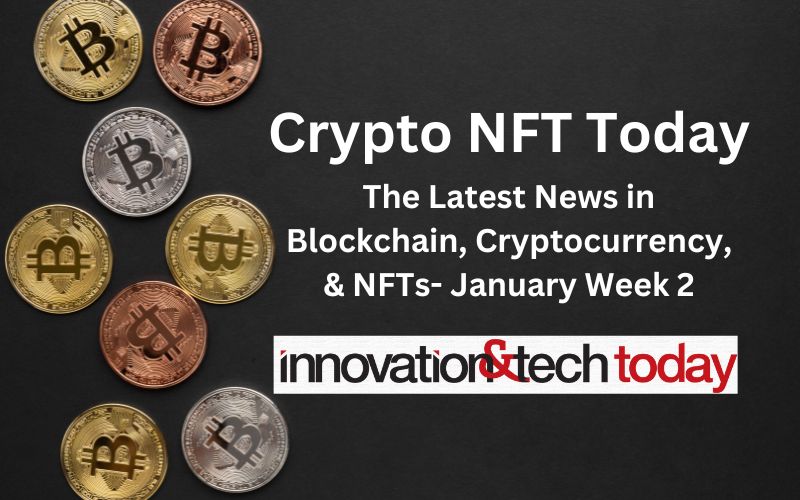Crypto
Iowan says he was robbed of $232,000 in cryptocurrency-romance scam – Iowa Capital Dispatch

A Webster County man is suing a group of unknown individuals behind a growing cryptocurrency-romance scam that allegedly cost him $232,793 and resulted in threats to harvest his organs.
The alleged theft occurred through an increasingly common scheme known as a “pig butchering.” In this sort of scam, victims are befriended by online perpetrators, then gradually “fattened” for financial slaughter. The victims are tricked into making investments though a website that mimics a legitimate cryptocurrency exchange.
Such scams are alleged to be responsible for more than $2 billion in losses incurred during 2022 alone.
In a newly filed federal lawsuit, Brian Hoop of Fort Dodge alleges that in September 2022, he received a text message on his cell phone from an unfamiliar phone number. The sender of the text introduced herself as “Emma” and indicated the text was intended for someone else.
Over the next six months, Hoop and “Emma” continued to text daily and eventually exchanged intimate messages and photos, with Hoop treating her as his girlfriend. Three months into their virtual relationship, in December 2022, “Emma” told Hoop she created substantial income for herself through carefully timed trades in cryptocurrencies and volunteered to assist Hoop in executing his own trades on what appeared to be a legitimate cryptocurrency exchange called Energise Trade.
Over the next several weeks, Hoop liquidated his retirement and savings accounts, borrowed money from a bank and from his mother, and ultimately delivered $232,793 to Energise Trade, believing his investment had resulted in $1.1 million in returns.
When he attempted to access those funds, he was asked to pay an additional $100,000 as payment of taxes. After he refused, “Emma” attempted to extort money from Hoop by threatening to expose his intimate conversations and photographs to others, and by threatening his safety and that of his family. The lawsuit alleges “Emma” specifically claimed to have hired agents who would ambush him, torture him and harvest his organs to be sold on the black market.
The lawsuit accuses the individual known only as “Emma” and 20 “John Does,” all believed to reside in China, with conversion, racketeering, conspiracy, unauthorized disclosure of intimate images, and negligent infliction of emotional distress. Also named as a defendant is a Delaware corporation named MEXC Global, which allegedly controls the accounts into which Hoop’s money was deposited.
The defendants’ actions, the lawsuit claims, are “not isolated events and are part of a widespread scheme to defraud other unsuspecting victims for the same or similar purposes and to achieve the same or similar results.”
The lawsuit seeks actual damages of at least $232,793; trebled damages, as allowed under federal law, of $698,378; statutory damages, as allowed under state law, of $10,000; punitive damages of at least $931,171; plus attorneys’ fees.
The defendants have yet to file a response to the lawsuit.
In March, the Federal Bureau of Investigation warned consumers of a huge spike in pig-butchering scams that are based on cryptocurrency exchanges. The bureau said the perpetrators were using fictitious identities to develop relationships with victims, often targeting people through dating apps, social media platforms, professional networking sites or encrypted messaging apps. Newer iterations of the scheme include so-called “liquidity mining” and “play-to-earn” games, according to the FBI.
In February, the Federal Trade Commission said that in 2022, nearly 70,000 people had reported being victimized in various romance scams, with their collective losses totaling $1.3 billion.

Crypto
Trump to designate cryptocurrency as a national priority

As President-elect Donald Trump begins a second term on Monday, he plans to issue an executive order making cryptocurrency a national priority, Bloomberg reports.
The order is meant to guide government agencies to work with the industry and possibly pause crypto-related litigation, according to Bloomberg, which cited unnamed people familiar with the matter. Trump also plans to create a crypto advisory council to advocate for the industry’s policies, per Bloomberg, and has suggested creating a national bitcoin stockpile.
This would mark a new era for crypto, an industry that collapsed two years ago after prices crashed. The period was marked by the fall of FTX, a leading exchange that went bankrupt that year. Its founder, Sam Bankman-Fried, was convicted of defrauding customers and sentenced to 25 years in prison.
The industry resurged in 2024, boosted by Trump, a former skeptic who pledged to turn the U.S. into the crypto capital of the world. Eager for a clear governing framework and a friendlier watchdog, donors poured tens of millions of dollars into pro-crypto candidates’ campaigns.
Dogecoin, a cryptocurrency with a dog mascot and billionaire Elon Musk as a fan, surged in value after Trump won and announced a non-governmental cost-cutting group nicknamed DOGE.
Trump then nominated crypto ally Paul Atkins to lead the Securities and Exchange Commission, the federal agency that led a crackdown under the Biden administration. Bitcoin surged to $100,000 for the first time following the announcement. “CONGRATULATIONS BITCOINERS!!! $100,000!!!” Trump wrote on Truth Social. “YOU’RE WELCOME!!!”
Crypto companies and investing platforms like Coinbase, Robinhood, Kraken and Ondo Finance Inc. have made $1 million donations to his inauguration. Ripple plans to donate $5 million in the form of its own digital token, and the industry is holding an “Inaugural Crypto Ball” to support Trump, Bloomberg reports.
Trump’s business interests include World Liberty Financial, a crypto platform he and his sons launched last year with Steve Witkoff, a friend and inaugural committee co-chair who has been named special Middle East envoy. The Trumps are not employees of the business but promote it, and an entity affiliated with Trump, DT Marks DEFI LLC, is entitled to receive 75% of the revenues.
In mid-November, the Financial Times reported that Trump Media — the parent company of Trump’s social media platform, Truth Social — was in talks to buy Bakkt, a crypto trading firm previously led by Kelly Loeffler, another co-chair of his inaugural committee.
Trump’s 2024 financial disclosures show he owned as much as $5 million worth of the crypto token ethereum, a crypto token that has surged in value since the election, according to The New York Times.
Read more
about cryptocurrency
Crypto
Donald Trump plans to make cryptocurrency a national priority: Report

Donald Trump, who is going to take office as the 47th US President on January 20, is planning to issue an executive order that will elevate cryptocurrency to a national priority in the United States, reported Bloomberg.
The move is expected to signal a policy shift and provide the crypto industry with a more prominent role in shaping government decisions.
According to sources mentioned in the report, the order will designate cryptocurrency as a national imperative, encouraging government agencies to collaborate with the industry. Additionally, it is likely to establish a cryptocurrency advisory council to advocate for the sector’s policy needs.
Bitcoin was trading at $101,021.39, with a market cap of $2 trillion at the time the article was being written.
CRYPTO INDUSTRY’S INFLUENCE
Donald Trump has received considerable support from the cryptocurrency industry, including donations from prominent companies such as Coinbase and Ripple to his inaugural committee. On Friday, just days before the beginning of his second term at the White House, the industry is set to host an “Inaugural Crypto Ball” in Washington, celebrating its ties with the incoming administration.
This initiative would represent a huge shift for the crypto sector, which has faced numerous regulatory challenges under President Joe Biden’s administration. Federal agencies, including the Securities and Exchange Commission (SEC), have launched more than 100 enforcement actions against crypto companies in recent years.
The proposed executive order may include a directive requiring all government agencies to review their policies on digital assets. There is also discussion about pausing ongoing litigation involving cryptocurrency firms, sources told Bloomberg. This could potentially halt legal actions against major players such as Binance Holdings Ltd. and Ripple Labs Inc., a move seen as a top priority by the industry.
CREATION OF NATIONAL BITCOIN STOCKPILE
Another key aspect under consideration is the creation of a national Bitcoin stockpile, the report mentioned.
The US government currently holds nearly $20 billion worth of Bitcoin, confiscated during various investigations, according to analytics firm Arkham. Bitcoin’s price has surged by nearly 50% since the November election, reaching over $100,000, partly due to speculation about the potential stockpile.
The proposed stockpile would formalise the government’s holdings of Bitcoin and reflect a strategic shift in how the US approaches cryptocurrency. Bitcoin has seen remarkable growth in 2024, with its value more than doubling over the year.
Kara Calvert, Vice President for US Policy at Coinbase Global Inc., commented on the importance of Trump’s potential move.
“What I think Donald Trump is going to do is signal that the United States is back and we are ready to lead in this industry. What it’s signaling to other countries is be careful, or you won’t keep up,” she told Bloomberg.
Trump has also made bold promises during his campaign, vowing to transform the US into the global capital of cryptocurrency. His administration is expected to issue several executive orders covering various industries within his first few days in office.
Despite facing regulatory hurdles during the Biden administration, the cryptocurrency industry in the US has continued to grow. Prominent financial firms, including BlackRock Inc., have launched spot Bitcoin and Ether exchange-traded funds (ETFs).
Tune In
Crypto
Crypto NFT Today: The Latest News in Blockchain, Cryptocurrency, & NFTs- January Week 2 – Innovation & Tech Today

Welcome to another edition of Crypto NFT Today! The past two weeks have been full of must-know events that will define the future of blockchain, cryptocurrency, and NFTs.
With cryptocurrencies jumping ahead of Trump’s inauguration, an inflation report for Bitcoin bringing encouragement, and more, there’s lots of essential news you should know about. So, let’s dive in and see what’s happening!
Cryptocurrencies Jump Ahead of Trump’s Inauguration
Cryptocurrencies surged on Thursday as investors shifted their focus to smaller, higher-risk coins ahead of President-elect Donald Trump’s inauguration.
XRP and litecoin were among the top performers, rising 13% and 22%, respectively, according to Coin Metrics. The CoinDesk 20 index, a broad crypto market indicator, gained nearly 5%. Meanwhile, bitcoin increased by less than 1%, hovering near $100,000 after a two-day rally of around 7% earlier this week. Ether dropped nearly 3% on Thursday.
Bitcoin’s Encouraging Inflation Report Releases
Bitcoin continued its rebound on Wednesday, hovering around $100,000 after another positive inflation report boosted investor risk appetite. The price of the leading cryptocurrency was up more than 3%, reaching $99,493.26, marking a 7% gain over the past two days, according to Coin Metrics. It peaked at $100,715.13 during late afternoon trading.
The CoinDesk 20 index, which tracks the broader cryptocurrency market, rose by 7%.Shares of Coinbase climbed 7%, while Bitcoin-related stocks MicroStrategy and Mara Holdings saw gains of 5% and 4%, respectively.
Litecoin May Receive ETF Soon
With U.S. President-elect Donald Trump’s inauguration a few days away and new leadership set to take over at the Securities and Exchange Commission (SEC), other cryptocurrencies beyond bitcoin (BTC) and ether (ETH) may soon be approved for their own spot exchange-traded funds (ETFs).
Litecoin (LTC) is expected to be the first to receive approval, according to Eric Balchunas and James Seyffart, ETF analysts at Bloomberg Intelligence. “Canary Funds just filed an amended S-1 for their litecoin ETF application. While there are no guarantees, this could signal SEC engagement on the filing,” Seyffart shared on X.
Expert Predicts Dogecoin Surge
The crypto market often follows a cyclical pattern, with past price movements helping analysts predict future trends. Analyst Martinez applied this strategy in his commentary on Thursday, suggesting that Dogecoin could see another significant rise starting next week.
Martinez pointed out that Dogecoin experienced a major uptrend in the week of January 25, 2021, following a 56% drop from its December high. To provide context, the meme token fell from $0.0143 in December 2021 to a low of $0.0067, before rebounding sharply and closing January with a 700% increase.
-
/cdn.vox-cdn.com/uploads/chorus_asset/file/25822586/STK169_ZUCKERBERG_MAGA_STKS491_CVIRGINIA_A.jpg)
/cdn.vox-cdn.com/uploads/chorus_asset/file/25822586/STK169_ZUCKERBERG_MAGA_STKS491_CVIRGINIA_A.jpg) Technology1 week ago
Technology1 week agoMeta is highlighting a splintering global approach to online speech
-

 Science6 days ago
Science6 days agoMetro will offer free rides in L.A. through Sunday due to fires
-
/cdn.vox-cdn.com/uploads/chorus_asset/file/25821992/videoframe_720397.png)
/cdn.vox-cdn.com/uploads/chorus_asset/file/25821992/videoframe_720397.png) Technology1 week ago
Technology1 week agoLas Vegas police release ChatGPT logs from the suspect in the Cybertruck explosion
-

 News1 week ago
News1 week agoPhotos: Pacific Palisades Wildfire Engulfs Homes in an L.A. Neighborhood
-

 Education1 week ago
Education1 week agoFour Fraternity Members Charged After a Pledge Is Set on Fire
-

 Business1 week ago
Business1 week agoMeta Drops Rules Protecting LGBTQ Community as Part of Content Moderation Overhaul
-

 Politics1 week ago
Politics1 week agoTrump trolls Canada again, shares map with country as part of US: 'Oh Canada!'
-
/cdn.vox-cdn.com/uploads/chorus_asset/file/23935558/acastro_STK103__01.jpg)
/cdn.vox-cdn.com/uploads/chorus_asset/file/23935558/acastro_STK103__01.jpg) Technology6 days ago
Technology6 days agoAmazon Prime will shut down its clothing try-on program













